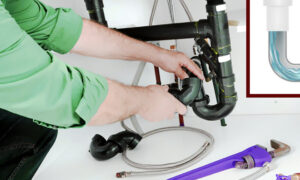A well-functioning plumbing system is the backbone of any household, ensuring convenience, hygiene, and comfort. However, when faced with issues such as clogged drains or leaky plumbing, even the most detailed designed systems can falter, causing inconvenience, potential damage, and significant expenses.
This comprehensive guide will look into these common plumbing problems, equipping you with the knowledge and strategies needed to tackle them effectively.
Understanding Clogged Drains:
Drains in sinks, showers, tubs, and toilets are prone to accumulating various forms of debris over time, ranging from hair and soap scum to food particles and grease. This build-up gradually obstructs the water flow, leading to partial or complete blockages. Recognizing the type of blockage is essential for determining the appropriate course of action.
Partial blockages manifest as slow drainage, showing that debris restricts water flow but has not completely blocked the pipe. In such cases, immediate intervention is necessary to prevent the problem from worsening. Start by refraining from using the affected fixture and attempting to clear the blockage using a plunger or drain snake.
If initial attempts prove unsuccessful or encounter a complete blockage where water cannot pass through, it’s vital to seek professional assistance like from https://www.plumbersingapore.org/ promptly. Avoid using chemical drain cleaners, which can worsen the problem and potentially damage your pipes, leading to costly repairs.
Preventative Measures:
Prevention is often the best defense against clogged drains. Implementing simple practices such as using drain guards to catch debris and avoiding disposing of grease and food scraps down the drain. You can periodically flush drains with hot water, and vinegar can help minimize the risk of blockages.
Additionally, regular maintenance, including professional kitchen sink tap replacement services in Singapore, can keep your plumbing system in optimal condition. It reduces the likelihood of clogs and ensures smooth water flow throughout your home.
Addressing Leaky Plumbing:
Leaky plumbing poses its own set of challenges, ranging from minor annoyances to significant structural damage. Whether it’s a dripping faucet, a hidden pipe leak, or a burst pipe causing flooding, swift action is essential to minimize the damage and prevent further complications.
Homeowners may attempt DIY repairs using essential tools and replacement parts for visible leaks, such as dripping faucets or under-sink leaks. However, it’s crucial to exercise caution and ensure that the underlying cause of the leak is appropriately addressed to prevent recurrence.
In cases where leaks are concealed within walls, ceilings, or floors, immediate intervention by a licensed plumber is necessary. Signs of hidden leaks include water stains, mold growth, musty odors, or unexplained spikes in water bills. Ignoring these warning signs can lead to extensive structural damage and mold growth, posing health risks to occupants.
Choosing a Reliable Plumbing Professional:
Selecting a reputable and experienced plumber is paramount when seeking assistance for plumbing issues. Avoid hiring the first plumber you come across, and conduct thorough research to identify qualified professionals with a track record of excellence.
Seek recommendations from trusted sources like friends, and family. Verify that the plumber is licensed, insured, and accredited by relevant industry organizations. Additionally, request references and inquire about warranties or guarantees offered on their services to ensure peace of mind and quality assurance.
Conclusion:
Dealing with clogged drains and leaky plumbing requires proactive maintenance, swift action, and reliance on skilled professionals. Homeowners can safeguard their plumbing systems and minimize the risk of costly repairs by understanding the underlying causes of these common plumbing problems and implementing preventative measures.
Remember to get the expertise of a qualified plumber to address plumbing issues promptly and effectively, ensuring the continued functionality and integrity of your home’s plumbing infrastructure.
































